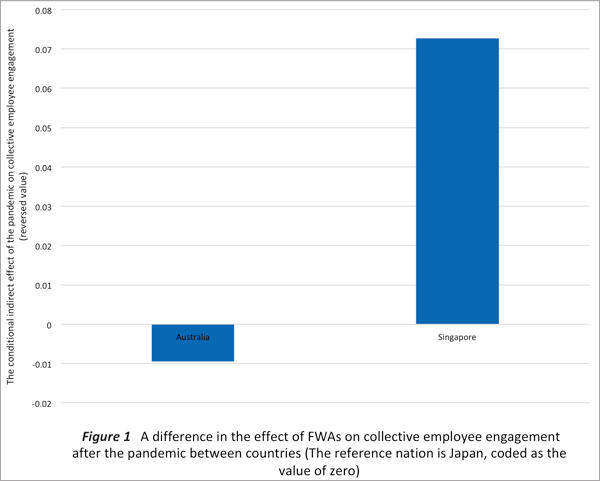The impact of the coronavirus pandemic on high performance work practices and collective employee engagement
Takashi SAKIKAWA
Professor, Faculty of Global Management, Chuo University
Research interests: strategic human resource management, organizational culture, and cross-cultural management
Evidence from Japan, Singapore, and Australia[1]
Introduction
It is reported that the economic impact of the ongoing COVID-19 pandemic is worse than that of the Great Recession in 2008 and that the world faces the worst recession since the Great Depression (Chan, 2020)[2]. A number of people in many parts of the world have lost their jobs. The unemployment rate is particularly high in the United States and European countries such as the UK and France (Alderman & Abdul, 2020)[3]. It may be that the economic recession has significantly affected and changed the way business organizations are run and their employees are managed.
New norms or guidelines of social life have appeared during the pandemic. Social distancing and staying home among other norms have caused people to isolate themselves from others and changed their behavior. In response to those new norms, an increasing number of companies have introduced teleworking and other measure such as staggered commuting and a four-day workweek. Employees at those companies are allowed to work from home and attend videoconference meetings. Companies have introduced or expanded flextime work schedules to promote teleworking.
The coronavirus pandemic has significantly had an economic and social impact on business organizations in a very short period of time. It is expected that organizations have been changed significantly in a short period of time since the outset of the pandemic. The pandemic may have affected or is currently affecting management practices and employees' engagement with their work and organizations. Against the backdrop of this ongoing situation involving the COVID-19 pandemic, I focus on high performance work practices among other practices and examine the impact of such a pandemic on those practices and the resulting collective employee engagements in Japan, Singapore, and Australia.
Pfeffer (1998)[4] and other researchers refer to the following practices as high performance work practices; a job security policy, extensive training, self-managed teams, job rotation, egalitarian teamwork practices, quality control activities, and other practices used by high-performing companies. Those high performance work practices are also called high commitment work practices (HCWPs) as they can improve the extent to which employees are committed to, engaged with, or passionate about their work--which ultimately leads to improvement in employee retention, productivity, product quality, profits, and other performance outcomes.
Meanwhile, Peretz, Fried, and Levi (2017) [5]and other researchers have regarded teleworking, a flextime work schedule, and other flexible work arrangements (FWAs) as high performance work practices. I discuss those high performance work practices, namely, HCWPs and FWAs, in this research.
Methods
In order to test hypotheses, I collected data through the online system of a research company in December 2020. I collected data from Japan, Singapore, and Australia. The economies of those three counties were not hit as hard by the pandemic as other nations such as the US and European countries when I started conducting the current survey. I thought that it was possible to collect much data from Japanese, Singaporean, and Australian employees still employed at that time. Respondents were managerial employees as I thought they were more knowledgeable about management and organizations than non-managerial employees. I made the English and Japanese versions of questionnaire. Japanese respondents used the Japanese version of questionnaire. One-hundred two Japanese managers, 114 Singaporean managers, and 110 Australian managers responded to the survey questionnaire. A total of 326 managers responded to the questionnaire.
All items were evaluated on a five-point Likert scale ranging from 1 "strongly disagree" to 5 "strongly agree." The questionnaire asked respondents to evaluate the mediator variable (HCWPs and FWAs), the dependent variable (collective employee engagement) and the moderator variable(the cultural dimension of collectivism versus individualism) that existed in December 2020, when survey was conducted (that is to say, after the outbreak of the pandemic) , and that had existed (or might still exist) before the end of 2019 (that is to say, before the outbreak of the pandemic). The pandemic is a dichotomous variable. The era of pre-coronavirus (before the pandemic) was coded as the value of one and the era of post-coronavirus (after the pandemic) was coded as the value of zero. A sample questionnaire item of HCWPs is" Job security of employees (the probability that they will keep their job) is guaranteed." A sample questionnaire item of FWAs is "Teleworking: Employees work from home for some or all of the working week by connecting to the workplace on a home computer." A sample question of collective employee engagement is "Employees feel proud to be part of the company." A sample question of collectivism versus individualism is "People tend to make decisions in the best interest of the group rather than for themselves."
Results
I performed statistical analyses. As a result, first, I found that the pandemic has had a significant impact on HCWPs. More specifically, those practices were used more extensively before the outbreak than after the outbreak on the one hand. Conversely, on the other hand, HCWPs are used less extensively after the outbreak of the pandemic.
Second, the pandemic has had a significant impact on FWAs. More specifically, those practices are used more extensively after the outbreak than before the outbreak.
Third, HCWPs mediate the impact of the pandemic on collective employee engagement. More specifically, employees were more engaged in their work before the outbreak than after the outbreak as HCWPs were used extensively before the pandemic. Conversely, employees are unlikely to be engaged in their work as HCWPs are used less extensively after the pandemic.
Fourth, FWAs mediate the impact of the pandemic on collective employee engagement. More specifically, employees are more engaged in their work after the outbreak than before the outbreak as FWAs are used more extensively after the pandemic.
Fifth, the effect of the pandemic on FWAs is stronger than the effect of the pandemic on HCWPs. Meanwhile, the effect of HCWPs on collective employee engagement is stronger than the effect of FWAs on collective employee engagement. Given those effects, the indirect effect of the pandemic on collective employee engagement through HCWPs is stronger than the indirect effect of the pandemic on collective employee engagement through FWAs.
The hypothesis was not supported that the indirect effect of the pandemic on collective employee engagement through HCWPs or FWAs is different depending on the level of the cultural dimension of collectivism versus individualism. I conducted supplementary analysis to further explore the role of organizational culture in affecting the indirect effect of the pandemic. As a result, I found that the effect of HCWPs on collective employee engagement varies as a function of the cultural dimension of performance orientation. But the conditional, indirect effect was negative, meaning that the effect of HCWPs on employee engagement before the pandemic decreased further as the nature of organizational culture became more performance-oriented.
I conducted additional analysis by making and using national dummies. I found that the indirect effect of the pandemic on collective employee engagement though FWAs is moderated by a national dummy of Singapore versus Japan and another dummy of Australia versus Japan. Figure 1 indicates that the indirect effect of the pandemic on collective employee engagement through the extensive use of FWAs after the pandemic is larger for Singapore than for Japan and is smaller for Australia than for Japan. As opposed to the theoretical prediction drawing on prior, FWA research, Singaporean and Japanese employees--who are collectivist than their Australian counterparts--covered by FWAs following the pandemic are more engaged in their work than their Australian counterparts.

Concluding remarks
The ongoing COVID-19 pandemic is the worst since Spanish flu in 1918. It has had a massive impact on the global economy and upended our lifestyle. Companies have changed their management practices in response to the economic recession and the new normal brought about by the pandemic. Against the backdrop of this situation, I focused on high commitment work practices (HCWPs) and flexible work arrangements (FWAs)-- constituting a system of high performance work practices--and examined the impact of the pandemic on collective employee engagement in Japan, Singapore, and Australia. A total of 326 managers responded to the questionnaire. HCPWs were used more extensively before the pandemic--which improved collective employee engagement. FWAs are used more extensively following the pandemic--which can also improve collective employee engagement. Engagement by employees covered by HCWPs or FWAs following the pandemic can vary between nations as well as between companies.
There are several limitations to this research. First, my research was conducted based on a retrospective design by asking respondents to recall and evaluate management practices before the pandemic as well as to assess current management practices after the pandemic. Second, I did not collect data from nations that had been hit hard by the pandemic and had seen unemployment skyrocket. Instead, I collected data from Japan, Singapore, and Australia, three nations that had not been hit as hard by the pandemic as many other nations when I started conducting my survey. The results should be read with caution by taking into account those limitations.
[1] This research study is funded by Japan Society for the Promotion of Science's (JSPS) KAKENHI Grant Number 20K01860.
[2] Chan, S. P. (2020, April 14). Coronavirus: 'World faces worst recession since Great Depression.' BBC News. Retrieved from https://www.bbc.com/news/business-52273988
[3] Alderman, L., & Abdul, G. (2020, October 29). Young and jobless in Europe: "It's been desperate." The New York Times. Retrieved from https://www.nytimes.com/2020/10/29/business/youth-unemployment-europe.html
[4] Pfeffer, J. (1998). The human equation: Building profits by putting people first. Boston, MA: Harvard Business Press.
[5] Peretz, H., Fried, Y., & Levi, A. (2018). Flexible work arrangements, national culture, organisational characteristics, and organisational outcomes: A study across 21 countries. Human Resource Management Journal, 28(1), 182-200.
Takashi SAKIKAWA
Professor, Faculty of Global Management, Chuo University
Research interests: strategic human resource management, organizational culture, and cross-cultural managementPhD in business administration from Aoyama Gakuin University
Books:
Organizational culture and innovation (in Japanese), Tokyo, Japan: Chikura Publishing Company, 1998.
Transforming Japanese workplaces, Hampshire, UK: Palgrave-Macmillan, 2012.








